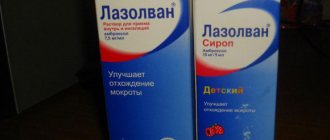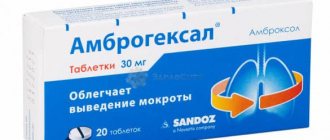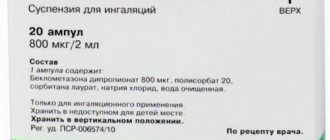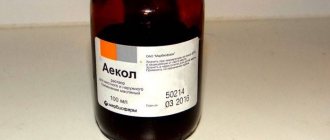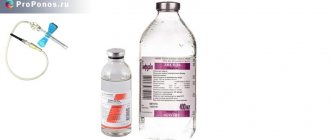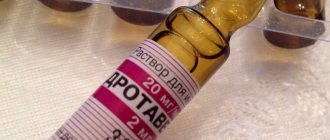Composition, physical and chemical properties, price
- Dosage form: solution intended for inhalation and internal use.
- Main substance: 7.5 mg ambroxol hydrochloride;
- Excipients: 2 mg citric acid monohydrate, 4.35 mg sodium hydrogen phosphate dihydrate, 6.22 mg sodium chloride, 225 mcg benzalkonium chloride, 98.9705 g. purified water.
- Physico-chemical properties: Transparent solution, light brown or colorless, 100 ml.
- Packaging: tinted glass bottles, with a polyethylene dropper and a measuring cup.
- Price: 350-400 rub.
special instructions
Lazolvan is not recommended to be combined with antitussive drugs. Due to their use, the cough center is suppressed, and the removal of sputum may be difficult. The solution contains benzalkonium chloride, which is a preservative; it can provoke bronchial spasms during inhalation if a person has increased reactivity of the respiratory system.
The drug can be mixed with liquids, excluding alkaline solutions and cromoglycic acid, as they cause an increase in the pH of the solution and precipitation. When following a low-sodium diet, be aware that it contains sodium. Dosage adjustment is necessary.
The instructions indicate that cases of severe skin lesions (Stevens-Johnson syndrome, epidermal toxic necrolysis) should be reported in people who took drugs containing ambroxol hydrochloride.
It is possible that these diseases arose against the background of a severe pathological process in the body or conservative treatment of the underlying disease; the manufacturer does not indicate the exact connection of the diseases with taking Lazolvan.
pharmachologic effect
Ambroxol hydrochloride activates the secretory function of the respiratory tract, enhances the production of surfactant (a substance lining the alveoli) and stimulates the motility of the cilia of epithelial cells in the bronchi. These effects can significantly improve the flow and transport of mucus through the bronchi - sputum discharge improves and the cough becomes less painful and more productive.
Long-term observations have proven that long-term therapy with Lazolvan in patients with COPD leads to a decrease in the number of exacerbations, a decrease in the duration of the acute period and the use of antibiotics.
Intravenous and respiratory forms of Lazolvan
In addition to oral forms, this drug can also be found on pharmacy shelves and in solutions for injection or inhalation.
Despite the fact that their use is not so popular among patients who prefer to “prescribe” their own treatment, the doctor will most likely give his preference to these medications in order to more quickly achieve a therapeutic effect. A notable feature of the use of Lazolvan in the form of injections is the need for slow administration of the drug. Otherwise, the patient may experience a sharp drop in blood pressure.
Pharmacokinetics
When used internally, absorption is almost complete and has a linear dependence on the dose taken in the therapeutic concentration range. The active substance reaches its maximum concentration in the blood one and a half to two hours after administration. At maximum concentration it binds to plasma proteins by 90%. It quickly passes from the blood into the tissues and is found in the highest concentration in the lung tissue.
A third of the dose taken undergoes the so-called primary passage through the liver tissue. The CYP3A4 isoform is involved in the metabolism of ambroxol hydrochloride to dibromanthranilic acid. Two-thirds of the dose taken is metabolized in the liver by partial breakdown to the metabolite dibromanthranilic acid and through glucuronidation. The half-life from the body is 10 hours.
The total clearance is 660 ml/min. After taking a single dose, about 83% is excreted in the urine over the next 5 days. Gender and age do not affect the pharmacokinetics of the active substance.
Reviews on the use of Lazolvan in children
Anastasia, 28 years old
The pediatrician prescribed Lazolvan to my 6-year-old son when he caught a bad cold in kindergarten. He said it can be given in drops or inhaled. I added the solution to my child’s tea; it was not possible to buy an inhaler. The cough began to subside after 2 days, and within 5 days it was completely gone. I was satisfied with the medication and did not notice any side effects.
Marianna, 29 years old
I have two children, and when they have a dry cough, I give them Lazolvan to breathe. A dry cough quickly turns into a wet cough and disappears completely within 5-6 days. No one had any side effects. I take it in the form of drops myself, when a cough appears, the effect is similar. I’m only dissatisfied with the price, in our city the drops cost 350 rubles, I heard that there are analogues with the same active ingredient that are several times cheaper, and they help very well, but I haven’t bought them yet.
Lyubov, 31 years old
I have known the drug for a long time; for the first time it was prescribed to my little daughter in the form of inhalations. She is 5 years old, and it is difficult to get her to sit with an inhaler, so I often give her drops with tea or compote. The drug has no taste or smell - this is a big plus, the child does not refuse to drink it. Even a severe paroxysmal cough that does not allow the child to sleep subsides within a couple of days. I am very pleased with the product, I recommend it to everyone I know who has children. There were no negative reactions, and I also never heard of side effects from my friends.
Dosage
Inhalations
The instructions for use of Lazolvan for inhalation for children indicate the following scheme:
- children under 6 liters: 1-2 inhalations per day, for which 2 ml of solution is used;
- children from 6 liters, as well as adults: 1-2 inhalations per day, for which 2-3 ml of solution is used.
Lazolvan is suitable for use for inhalation with any modern inhalers, except steam ones. To obtain a working solution of Lazolvan for children for inhalation, the drug is mixed with 0.9% sodium chloride solution in a one-to-one ratio. The drug is prepared in the same way for use by adults.
Inhalations are carried out in normal breathing mode, since a deep breath can provoke a coughing attack. The solution (a mixture of saline and Lazolvan) must be slightly warmed before inhalation. For patients who have bronchial asthma, inhalations should be carried out after taking bronchodilators.
Internal reception
1 ml of Lazolvan solution is 25 drops. The drug can be dissolved in water, juice, tea, milk and used regardless of food intake:
- children under 2 liters: 25 drops (equal to 1 ml) twice a day;
- children 2-6 years old: 25 drops (equal to 1 ml) three times a day;
- children 6-12 liters: 50 drops (equal to 2 ml) three to two times a day;
- children over 12 liters and adults: 100 drops (equal to 4 ml) three times a day.
If symptoms persist for more than 4-5 days during treatment with Lazolvan, the drug is discontinued and a doctor is consulted.
Side effects, overdose
If you take the drug according to the manufacturer's instructions, side effects are extremely rare. Negative manifestations are possible due to individual intolerance to the substances included in the composition. Side effects:
- nausea;
- abdominal pain;
- excessive salivation;
- diarrhea;
- bloating;
- hives;
- skin rash;
- skin itching;
- allergic rhinitis;
- airway spasm.
Read more Instructions for using Artelak Balance eye drops
Long-term use may cause taste disturbances. The manufacturer does not indicate any cases of overdose during the existence of the mucolytic drug.
If the number of drops is regularly exceeded, or the frequency of dosing per day is increased, the digestive system may be upset and severe side effects may appear. If a person has taken a large dosage or the solution has been accidentally drunk, induce vomiting and take a sorbent (activated carbon, Polysorb or others). If disorders of the gastrointestinal tract or respiratory system occur, you must consult a doctor to carry out symptomatic therapy.
Pregnancy, lactation period
The active substance penetrates well into the placental bloodstream. In the course of preclinical studies, no direct or indirect negative effects on the course of pregnancy and fetal development were identified. In women who took Lazolvan after 23 weeks of pregnancy, no negative effects were found on the course of pregnancy, childbirth and fetal development. Ambroxol is also excreted in mother's milk.
Like any other drug, Lazolvan is prescribed with caution both during pregnancy and during the entire period of breastfeeding.
Additional Information
The manufacturer indicates that while taking the drops, there is no limitation in driving or performing work that requires a quick psychomotor reaction, although no studies have been conducted on the effect of Lazolvan on the ability to drive.
Use during pregnancy and breastfeeding
The main substance of the drops passes through the placental barrier, so Lazolvan cannot be used in the first trimester of pregnancy, in 2.3 at the discretion of the doctor. The study did not reveal any dangerous effects on the fetus or the mother's body, but precautions are still necessary. Ambroxol hydrochloride passes into breast milk, so you should not feed your baby during treatment. Although, studies have not proven the harmful effects of Lazolvan on the body of infants.
Use for kidney and liver diseases
If the functioning of organs is impaired, the use of the drug is not prohibited, but caution is necessary. The liver transforms the active substance to improve its therapeutic effect and further excretion. About 80% of the drug is excreted through the kidneys; if their function is impaired, the process may slow down. In case of renal failure, toxic substances accumulate in the body, negatively affecting the functioning of organs and systems. In this connection, the effect of the drug may be blocked or enhanced.
Read more Dexamethasone: what are eye drops prescribed for?
Contraindications
For all dosage forms:
- First trimester of pregnancy;
- Breastfeeding period;
- Hypersensitivity to ambroxol or auxiliary components.
Additional contraindications depending on the dosage form:
- Syrup: children under 6 years of age (for syrup at a dose of 30 mg/5 ml), hereditary fructose intolerance;
- Tablets: age under 18 years, lactose intolerance, lactase deficiency, glucose-galactose malabsorption;
- Lozenges: children under 6 years of age, hereditary fructose intolerance.
Lazolvan is used with caution in the second and third trimesters of pregnancy, as well as in case of renal and/or liver failure.
Nosological classification (ICD-10)
The International Classification of Diseases, Tenth Revision (ICD-10) is a standard assessment tool in the fields of health care management, medicine, epidemiology, and general health analysis. According to ICD-10, the drug Lazolvan can be used for the following diseases and conditions:
- J18 Pneumonia without specifying the pathogen,
- J20 Acute bronchitis,
- J22 Acute respiratory infection of the lower respiratory tract, unspecified,
- J42 Chronic bronchitis, unspecified,
- J44 Other chronic obstructive pulmonary disease,
- J45 Asthma,
- J47 Bronchiectasis (bronchiectasis is an irreversible expansion of the bronchial tube due to damage to the bronchial wall),
- R09.3 Sputum.
The term “specified” disease (condition) is used in cases where the doctor has a complete package of medical documents that allow the development of the disease (condition) to be assessed as objectively as possible. In a situation where this set of documents is missing, and the state of the internal organs cannot determine the course of the disease, a diagnosis of “ unspecified ” is made.
back
Indications for inhalations
With the help of inhalers, dispersed particles of the drug fall directly into the focus of the inflammatory process, so these procedures can be done at any stage of the disease. Inhalation therapy is carried out repeatedly throughout the day, an hour and a half after meals. Drugs that increase mucus are not administered by aerosol at night. Inhalations are best performed for infants during sleep, using a special mask.
